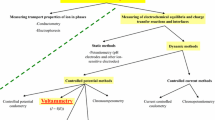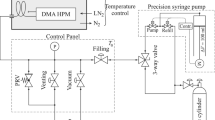Summary
In the horizontal KS chamber, the chromatographic layer can be conditioned in a controlled manner, before and after development with certain chromatographically effective vapours. For this purpose, the plate, with its face downwards, is placed over a dish filled with the appropriate “conditioning liquid”. The dishes are square and have various divisions. This allows the mobile phase to be modified in both, the horizontal and vertical direction, i.e. forming gradients. The transverse gradient makes it possible to try out several different conditions side by side on the same plate and to optimize the separation in a minimum of time. This chamber system also permits the simulation of development conditions in classical TLC chambers; it can therefore also be used for “normal” TLC. Practical examples of homogenous and gradient precoating with substances of higher or lower polarity than the solvent are given. A combination of gradient and flow-through chromatography is demonstrated. With suitable methods it is possible, as in the solvent-gradient technique, to overcome very high polarity ranges in the solvent mixture. Finally, it is pointed out that the terms “solvent” and “mobile phase” must be strictly differentiated in TLC.
Zusammenfassung
In der horizontalen KS-Kammer kann man die chromatographische Schicht vor und während der Entwicklung kontrolliert mit bestimmten, chromatographisch wirksamen Gasmolekülen “vorbeladen”. Dazu liegt die Platte, Schicht nach unten, über einem Trog, der mit der jeweiligen “Konditionierflüssigkeit” gefüllt ist. Die quadratischen Tröge besitzen verschiedene Unterteilungen und sind untereinander auswechselbar. Damit ist es möglich, die mobile Phase längs und quer zur Laufrichtung zu beeinflussen, d.h. Gradienten auszubilden. Der Quergradient erlaubt, mehrere Bedingungen nebeneinander auf der gleichen Platte auszuprobieren und die Trennung schnell zu optimieren. Mit diesem Kammersystem lassen sich auch die Entwicklungsverhältnisse in klassischen DC-Kammern simulieren; es kann infolgedesse auch leicht für die “normale” DC eingesetzt werden. Dann werden praktische Beispiele von homogener und Gradienten-Vorbedampfung mit Stoffen, die polarer oder unpolarer als das Fließmittel sind, gebracht. Ebenso wird die Kombination von Gradiententechnik und Durchlaufchromatographie veranschaulicht. Durch geeignete Maßnahmen können, wie bei der Fließmittelgradienten-Technik, im Probengemisch sehr große Polaritätsspannen überbrückt werden. Es wird schließlich darauf hingewiesen, daß die Begriffe “mobile Phase” und “Fließmittel” in der DC streng von einander zu trennen sind.
Sommaire
Dans la chambre horizontale «KS» la couche mince de sorbant peut recevoir une «précharge gazeuse» controlée, avec des molécules gazeuses déterminées, avant et pendant l'élution. La plaque avec la couche orientée vers le bas, est placée au-dessus d'un moule contenant des «solutions de conditionnement». Les moules des formes carrées et à subdivisions variées sont interchangeables. On peut influencer ainsi la phase mobile dans le sens de migration ou dans la direction perpendiculaire, c'est à dire établir des gradients. L'optimisation d'une séparation peut se faire rapidement sur une seule plaque en se servant du gradient transversal. Le système peut être utilisé également comme les chambres chromatographiques classiques. La «KS» permet d'associer la technique de gradients et celle de chromatographie continue. Nous donnons quelques exemples pratiques de «précharge gazeuse» homogène ou en gradient avec des substances plus polaires ou moins polaires que l'éluan. Nous avons pu couvrir une vaste gamme de polarité dans les mélanges á séparer sur une seule plaque chromatographique par un procédé qui donne des résultats analogues à ceux de la technique conne du gradient d'éluants. Nous attirons l'attention sur la necessité d'établir une distinction nette entre «phase mobile» et «éluant».
Similar content being viewed by others
Literatur
Brenner, M. undNiederwieser, A., Experientia (Basel)17, 237 (1961)
Hesse, G. undAlexander, M. Journées Internationales d'Etudes des Méthodes de Séparation Immédiate par Chromatographie, Paris 1961, GAMS-Publikation, Paris 1962; S. 229
Geiss, F. undSchlitt H., Chromatographia1, 387 (1968)
Geiss, F., Schlitt, H. undKlose, A., Z. anal. Chemie213, 321, 331, (1965)
Truter, E.V., J. Chrom.14, 57 (1964)
Geiss, F. undSchlitt, H., J. Chromat.33, 208 (1968)
Niederwieser, A. undHonegger, C.G., Helv. Chim. Acta48, 893 (1965)
Dallas, M.S.J., J. Chromat.17, 267 (1965)
Geiss, F., J. Chromat.33, 9 (1968)
Geiss, F., Schlitt, H., Ritter, F.J. undWeimar, W.M., J. Chromat.12, 469 (1963)
Zeeuw, R.A. de, J. Chromat.32, 43 (1968)
Dijk, J.H. van undMijs W.J., Z. anal. Chem.236, 419 (1968)
Stahl, E., Chem. Ing.-Tech.36, 941 (1964)
Brenner M. undNiederwieser, A.: Desaga-Druckschrift zur BN-Kammer, Heidelberg
Niederwieser, A. undHonegger, C.G., in “Advances in Chromatographie2, Hrsg. J.C. Giddings u. R.A. Keller. Dekker, New York 1966, S. 123
Prinzler, H.W. undTauchmann, H., J. Chromat.29, 142 (1967)
de Zeeuw, R.A., Anal. Chem.40, 915 (1968)
Author information
Authors and Affiliations
Rights and permissions
About this article
Cite this article
Geiss, F., Schlitt, H. Ein neues, vielseitiges Entwicklungssystem zur Dünnschicht-Chromatographie („KS-Variokammer”). Chromatographia 1, 392–402 (1968). https://doi.org/10.1007/BF02268719
Received:
Accepted:
Issue Date:
DOI: https://doi.org/10.1007/BF02268719




